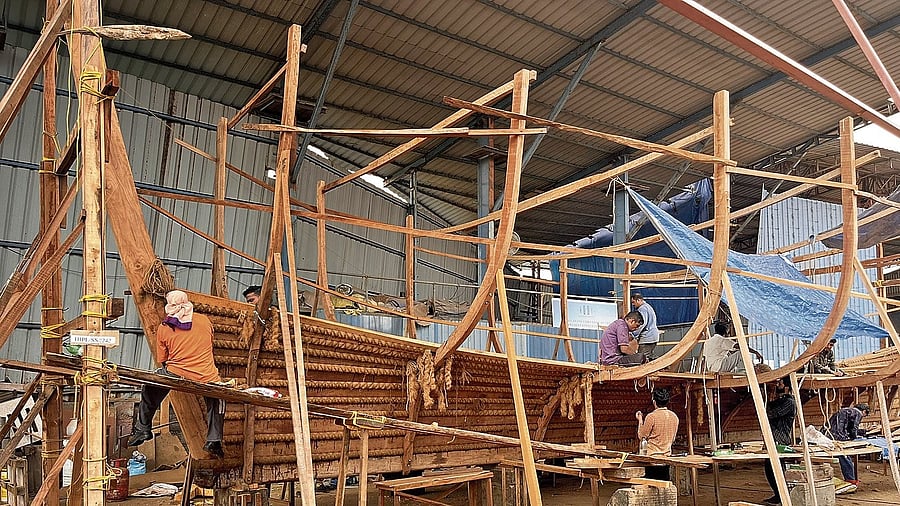
Workers constructing the INSV Kaundinya without modern machinery; the vessel sets sail on the sea.
Photo courtesy: Indian Navy
The Indian Navy, known for its formidable fleet of large warships such as INS Vikramaditya and INS Vikrant—both capable of carrying advanced fighter jets—has recently inducted a unique, small-sized vessel named INSV Kaundinya.
This addition raises an intriguing question: What purpose does a modest-sized vessel serve alongside these massive warships? What is its true significance?
According to Navy officials, INSV Kaundinya is no ordinary vessel; it is a carefully crafted replica based on a 5th-century BC design, paying homage to ancient India’s legacy in naval navigation.
“At a time when the world had little knowledge of sea voyages, the ancient sage Kaundinya undertook maritime journeys across the Indian Ocean. This vessel symbolises that rich maritime heritage,” the spokesperson of the navy explained.
The story of INSV Kaundinya is captivating.
Constructed at the Hodi Innovations Private Limited shipyard on the banks of Goa’s Mandovi River, the vessel was later transported to the Kadamba naval base in Karwar for commissioning.
Despite the availability of modern technology and equipment, it was built entirely without machinery. The boat’s frame consists of wooden planks sourced from Kerala’s forests, bound together with ropes made from coconut fibre—an arresting sight that celebrates India’s ancient shipbuilding traditions.
Adding to its visual appeal are its distinctive features: the Kadamba dynasty’s royal emblem—the mythical Gandaberunda bird—adorns the figurehead, while a lion emblem graces the prow.
Babu Shankaran, the skilled Kerala shipwright behind this masterpiece, explains, “The hull is square-shaped from bottom to top, designed specifically to withstand the turbulent waves of the deep sea without capsizing. Remarkably, there is not a single machine on the entire vessel.”
He proudly adds, “The boat is built entirely from wooden planks. These planks are joined using coconut fibre ropes. The vessel follows a construction method that dates back 2,500 years, untouched by modern technology.”
Constructing a seaworthy vessel requires strong and durable materials. To this end, extensive searches were conducted across the forests of Kannur and Wayanad in Kerala. Various types of timber, including jackfruit wood, were sourced for the planks. These were treated with a mixture of fish oil, neem powder, and animal fats—time-tested natural preservatives that enhance durability and lifespan, he explained.
The ambitious project began in 2023 with a dedicated team of over 20 skilled craftspeople.
“We had no detailed blueprints or maps when we started. Throughout the project, Navy officials and technical experts from IIT Madras guided us, ensuring authenticity and precision,” says Shankaran.
(Translated from Kannada by Divyashri Mudakavi)
ಗೋವಾದಲ್ಲಿ ಮೊದಲ ಬಾರಿಗೆ ಸಮುದ್ರಕ್ಕೆ ಇಳಿದಾಗ ಐಎನ್ಎಸ್ವಿ ಕೌಂಡಿನ್ಯ ಹೀಗೆ ಸಾಗಿತ್ತು.